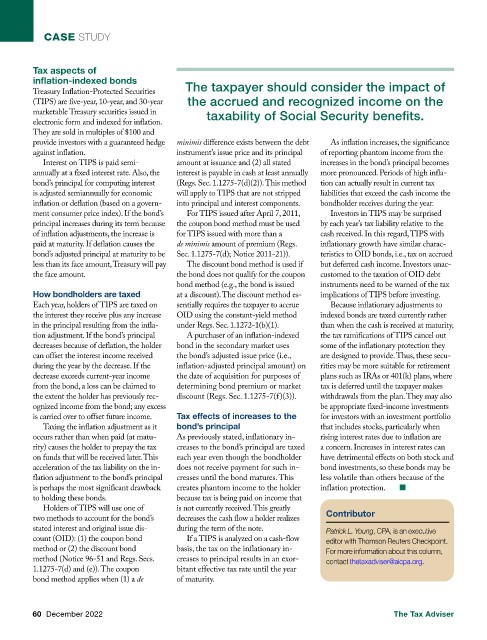Page 669 - TaxAdviser_2022
P. 669
CASE STUDY
Tax aspects of
inflation-indexed bonds The taxpayer should consider the impact of
Treasury Inflation-Protected Securities
(TIPS) are five-year, 10-year, and 30-year the accrued and recognized income on the
marketable Treasury securities issued in taxability of Social Security benefits.
electronic form and indexed for inflation.
They are sold in multiples of $100 and
provide investors with a guaranteed hedge minimis difference exists between the debt As inflation increases, the significance
against inflation. instrument’s issue price and its principal of reporting phantom income from the
Interest on TIPS is paid semi- amount at issuance and (2) all stated increases in the bond’s principal becomes
annually at a fixed interest rate. Also, the interest is payable in cash at least annually more pronounced. Periods of high infla-
bond’s principal for computing interest (Regs. Sec. 1.1275-7(d)(2)). This method tion can actually result in current tax
is adjusted semiannually for economic will apply to TIPS that are not stripped liabilities that exceed the cash income the
inflation or deflation (based on a govern- into principal and interest components. bondholder receives during the year.
ment consumer price index). If the bond’s For TIPS issued after April 7, 2011, Investors in TIPS may be surprised
principal increases during its term because the coupon bond method must be used by each year’s tax liability relative to the
of inflation adjustments, the increase is for TIPS issued with more than a cash received. In this regard, TIPS with
paid at maturity. If deflation causes the de minimis amount of premium (Regs. inflationary growth have similar charac-
bond’s adjusted principal at maturity to be Sec. 1.1275-7(d); Notice 2011-21)). teristics to OID bonds, i.e., tax on accrued
less than its face amount, Treasury will pay The discount bond method is used if but deferred cash income. Investors unac-
the face amount. the bond does not qualify for the coupon customed to the taxation of OID debt
bond method (e.g., the bond is issued instruments need to be warned of the tax
How bondholders are taxed at a discount). The discount method es- implications of TIPS before investing.
Each year, holders of TIPS are taxed on sentially requires the taxpayer to accrue Because inflationary adjustments to
the interest they receive plus any increase OID using the constant-yield method indexed bonds are taxed currently rather
in the principal resulting from the infla- under Regs. Sec. 1.1272-1(b)(1). than when the cash is received at maturity,
tion adjustment. If the bond’s principal A purchaser of an inflation-indexed the tax ramifications of TIPS cancel out
decreases because of deflation, the holder bond in the secondary market uses some of the inflationary protection they
can offset the interest income received the bond’s adjusted issue price (i.e., are designed to provide. Thus, these secu-
during the year by the decrease. If the inflation-adjusted principal amount) on rities may be more suitable for retirement
decrease exceeds current-year income the date of acquisition for purposes of plans such as IRAs or 401(k) plans, where
from the bond, a loss can be claimed to determining bond premium or market tax is deferred until the taxpayer makes
the extent the holder has previously rec- discount (Regs. Sec. 1.1275-7(f)(3)). withdrawals from the plan. They may also
ognized income from the bond; any excess be appropriate fixed-income investments
is carried over to offset future income. Tax effects of increases to the for investors with an investment portfolio
Taxing the inflation adjustment as it bond’s principal that includes stocks, particularly when
occurs rather than when paid (at matu- As previously stated, inflationary in- rising interest rates due to inflation are
rity) causes the holder to prepay the tax creases to the bond’s principal are taxed a concern. Increases in interest rates can
on funds that will be received later. This each year even though the bondholder have detrimental effects on both stock and
acceleration of the tax liability on the in- does not receive payment for such in- bond investments, so these bonds may be
flation adjustment to the bond’s principal creases until the bond matures. This less volatile than others because of the
is perhaps the most significant drawback creates phantom income to the holder inflation protection. ■
to holding these bonds. because tax is being paid on income that
Holders of TIPS will use one of is not currently received. This greatly Contributor
two methods to account for the bond’s decreases the cash flow a holder realizes
stated interest and original issue dis- during the term of the note. Patrick L. Young, CPA, is an executive
count (OID): (1) the coupon bond If a TIPS is analyzed on a cash-flow editor with Thomson Reuters Checkpoint.
method or (2) the discount bond basis, the tax on the inflationary in- For more information about this column,
method (Notice 96-51 and Regs. Secs. creases to principal results in an exor- contact thetaxadviser@aicpa.org.
1.1275-7(d) and (e)). The coupon bitant effective tax rate until the year
bond method applies when (1) a de of maturity.
60 December 2022 The Tax Adviser

